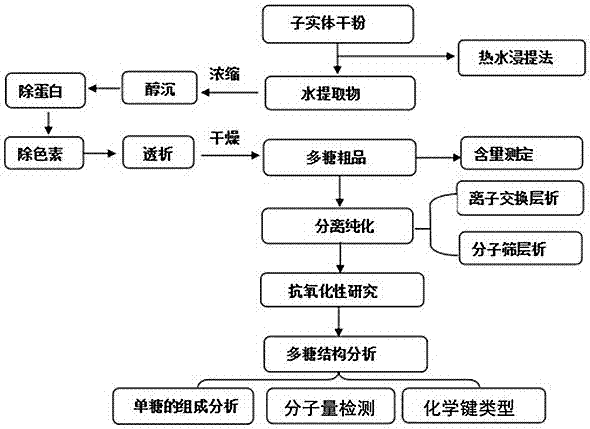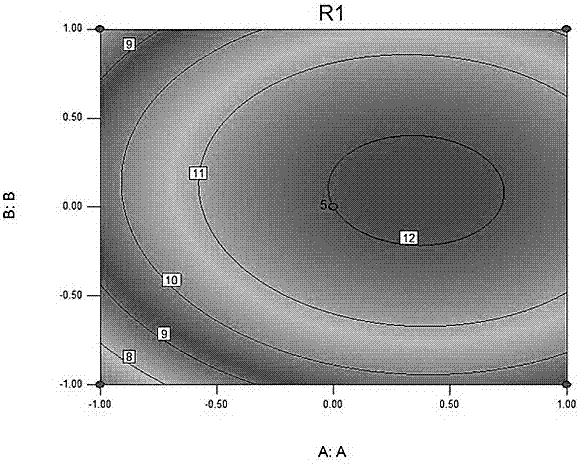Leccinum extremiorientale antioxidant polysaccharides and extracting and separating process thereof
A technology for oxidizing polysaccharides and boletus, which is applied in the fields of anti-virus, food science, drug combination, etc., to achieve the effect of product safety
- Summary
- Abstract
- Description
- Claims
- Application Information
AI Technical Summary
Problems solved by technology
Method used
Image
Examples
Embodiment 1
[0028] Example 1 Optimization of Polysaccharide Extraction and Separation Conditions of Boletus fareastica Boletus
[0029]1. Pretreatment of raw materials: Weigh 2g of Boletus farrescens fruiting bodies, dry, crush, pass through a 100-mesh sieve, add 4 times the volume of 80% ethanol (w / v=1:4), and place in a water bath at 60°C Bath in medium water for 2 hours, centrifuge at 3500 rpm for 5 minutes, take the precipitate, and evaporate to dryness in a water bath at 60°C to obtain defatted boletus fruiting body powder, which is stored for future use.
[0030] After extracting the defatted boletus fruiting body powder with hot water, centrifuge at 3500rpm for 10 minutes to obtain the polysaccharide supernatant, concentrate it to 1 / 3 of the original volume with a rotary evaporator, add 4 times the volume of 80% ethanol at 35-40°C, and heat at 4°C Precipitate with alcohol for 24 hours, centrifuge at 3500rpm for 10-15min, take the polysaccharide supernatant, mix the supernatant with...
Embodiment 2
[0051] Example 2 Detection of antioxidant activity of boletus polysaccharide LEP-2
[0052] 1. Determination of scavenging·OH activity: prepare 9mmol / L FeSO 4 (Preparation now), 9mmol / L salicylic acid-ethanol solution, 20mmol / L H 2 o 2 (Liu, 2016). Add each reaction solution sequentially according to Table 4, react at 37°C for 1 hour, and measure OD 510nm value, without sample, denoted as A 0 ; There is a sample, denoted as A 1 ;no H 2 o 2 , denoted as A 2 ;V C as a positive control.
[0053] OH scavenging rate (%) = [1-(A 1 -A 2 ) / A 0 ]×100
[0054] Table 4 Determination of hydroxyl radical scavenging ability of polysaccharides
[0055] components
[0056] 2. Clear O 2 - Determination of activity: prepare 50 mM Tris-HCl (pH=8.2), 0.05-1 mg / mL polysaccharide solution, and 25 mM pyrogallol solution (Liu, 2015). Add the reaction solution according to Table 5, and react at 25°C for 5 minutes. The reaction was stopped with 1 mL of 8 mM HCl. Measure OD ...
Embodiment 3
[0065] Example 3 Structural Analysis of the Antioxidant Polysaccharide LEP-2 of Boletus fareasterensis
[0066] 1. Analysis of monosaccharide components
[0067] (1) Pretreatment for determination of monosaccharide composition: Weigh 8.2mg of fibrous LEP-2 and place it in a high temperature resistant glass tube, add 2mL of 2mol / L trifluoroacetic acid (TFA), and blow N 2 , After removing the air in the glass tube, seal it quickly. Hydrolyze at 121°C (oil bath) for 2h. The sample solution was diluted 50 times and injected.
[0068] (2) Chromatographic conditions: use high performance liquid chromatography to analyze the monosaccharide composition of LEP-2, and measure the OD 250nm value; keep the temperature of the column at room temperature; and the elution flow rate is 0.5mL / min; the mobile phase is as follows:
[0069] time (min)
water(%)
250mM NaOH(%)
0
98
2.0
30
98
2.0
[0070] (3) Preparation of monosaccharide standard sub...
PUM
 Login to View More
Login to View More Abstract
Description
Claims
Application Information
 Login to View More
Login to View More - R&D
- Intellectual Property
- Life Sciences
- Materials
- Tech Scout
- Unparalleled Data Quality
- Higher Quality Content
- 60% Fewer Hallucinations
Browse by: Latest US Patents, China's latest patents, Technical Efficacy Thesaurus, Application Domain, Technology Topic, Popular Technical Reports.
© 2025 PatSnap. All rights reserved.Legal|Privacy policy|Modern Slavery Act Transparency Statement|Sitemap|About US| Contact US: help@patsnap.com



